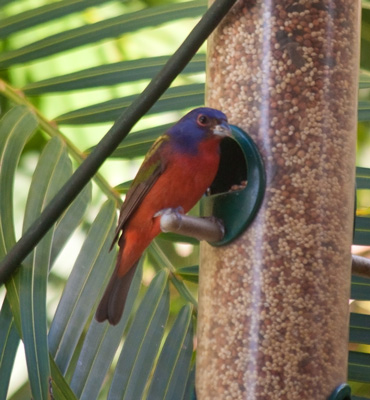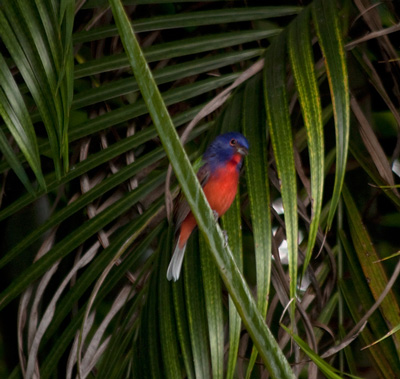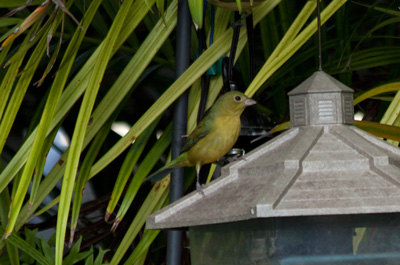I will never forget the first time that I saw them. They were almost too colorful to be believed! My jaw dropped with amazement at the vision before me. Here was a small bird with an iridescent violet-blue head, green back and cherry-red chest and underbelly.
I was watching a male painted bunting at a feeder at the edge of Castellow Hammock, in Homestead. There were other males and some similar-sized birds that were a muted, soothing green. I later learned that these were called greenies and could either be female painted buntings or immature males.

A gloriously colored male painted bunting at a feeder. Kenneth Setzer/FTBG.
I sat on a bench about 20 feet from the feeder and the birds. I was transfixed by these birds flying quickly back and forth from the shrubby undergrowth of the hammock and the feeder filled with seeds. The painted buntings seemed a bit shy and nervous, quickly disappearing into the woods.
I first saw these birds at Castellow nearly 35 years ago. Many years after this, I purchased my first home, in an old neighborhood of Homestead. Just six months after Hurricane Andrew, my new yard had few plants. I decided to create my own South Florida hardwood hammock and pine rockland habitats within my yard to attract wildlife.
The creation of the hammock began with the planting of two small wild tamarind (Lysiloma latisiliquum) trees and several kinds of stoppers — white stopper (Eugenia axillaris), red stopper (Eugenia rhombea), red berry stopper (Eugenia confusa) and Simpson’s stoppers (Myrcianthes fragrans). In addition, I planted a few lignum-vitaes (Guaiacum sanctum) and on the sunny, south edge of the hammock, I planted two Mexican alvaradoa (Alvaradoa amorphoides) and some wild sage (Lantana involucrata).
In just a few years, I had my very own shady woods — my private hardwood hammock! This type of habitat provided the shrubby, thick growth that painted buntings prefer.
I purchased a couple bird feeders and started keeping them filled with bird seeds. I also attended a local meeting of the Painted Bunting Observer Team. I learned that painted buntings have a relatively small range. According to the observer team, painted buntings breed in two separate areas in the United States: The eastern population breeds along the southeast coast (North and South Carolina, Georgia, and the eastern coastline of north and central Florida). The western population breeds in Kansas and Missouri south to Texas and Louisiana.
Painted buntings migrate south between early October and mid-November. Eastern painted buntings fly to central and southern Florida, Cuba or the Yucatan peninsula of Mexico. Western painted buntings winter in Mexico and Central America. We see birds of the eastern populations down here from October through the first half of April.
My feeders are hung on branches of the two Mexican alvaradoa, which are on the southern edge of the hammock. This year “my” painted buntings first appeared on Oct. 7. Two outrageously hued males visited my feeders, enjoying the white millet seeds in the finch seed mix that I use. Within a few days the two painted buntings were joined by additional males and greenies. As of this writing I have seen as many as 10 painted buntings at my feeders.

A male painted bunting. Painted buntings are very shy birds. Kenneth Setzer/FTBG.
The type of feeder that I find most used by the painted buntings is the caged feeder, which is a tube-type feeder surrounded by a wire cage that allows small birds through, but keeps bigger birds from accessing the seed. I also have a second feeder several feet away.
I learned that painted buntings’ favorite food is white millet seeds. I use a finch seed mix (mostly millet) which does not include sunflower seeds or corn. This seed mix is available in local feed stores. I add seed to the feeders daily and provide fresh water in a nearby bird bath.

A female painted bunting, or greenie. Kenneth Setzer/FTBG.
I feel honored that some of the wonderful painted buntings, the most colorful birds native to North America, spend the months of October through April in my yard. If you provide the right habitat and plants, food and water you can enjoy them in your yard too. Get to work!
Mary Collins is senior horticulturist at Fairchild Tropical Botanic Garden.
